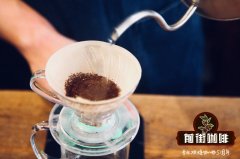What looks like a baking flaw? What is the flavor of baking defects? What are the effects of flavor?

Professional coffee knowledge exchange more coffee bean information please follow the coffee workshop (Wechat official account cafe_style)
Moderate
"American baking". If it is a little darker than moderate, it may be "urban", also known as "normal" or "brown": make the color as dark as possible without oil on the surface.
Viennese style
An American term meaning slightly darker than medium baking. This baking has dark brown spots and a little oil on the surface. Also known as "light French" or "citywide" baking.
depth
"Spanish", "Cuban". Coffee beans have a little oil on the surface, sometimes called "dark brown" or "French roasting."
Continental type
It can also be called "double baking"; "high". In the United States, it is divided into "French baking", "New Orleans baking" and "European" baking. The roasted coffee beans have a similar dark chocolate color and can be described as "deep", "deep French", "heavy" and "Italian" roasting.
Italian style
In the United States, this kind of baking is deeper in color mastery than in Italy, and is sometimes called "concentrated" baking. This coffee bean is almost black and very oily. Its main taste comes from the taste of baking rather than coffee. Coffee beans should never be burned black.
Baked Coffee roasted coffee beans
The long baking time before explosion is the main reason for the production of baked coffee. Unfortunately, this flaw is not visible to the naked eye and can only be identified by taste. Usually, baked coffee is accompanied by a plain flavor and no sweetness, which is described as bread or paper.
The development of Underdevelopment is incomplete
Underdeveloped beans tend to have a "grassy smell" and lack the aroma of caramel. When the bean baker wants to do shallow baking, sometimes the development is not complete. At this point, the baker needs to adjust the baking curve slightly.
Overdevelopment is overdeveloped.
The opposite of incomplete development is overdevelopment. There is only a slight difference between "deep baking" and "overdevelopment". According to Matt Perger, there is no such thing as "overdevelopment".
However, it is still a mistake to bake deeper than expected, which is a flavor that many professional consumers do not like. These coffee beans look black, oily and sometimes even scorched. The cup test will have a charred, bitter taste, with a smoky and peat flavor.
Quaker bean
Quaker beans are essentially immature coffee raw beans, which are difficult to identify in manual sorting of raw beans. They are usually caused by poor soil and limit the accumulation of sugar and starch during growth. Technically, this is not a baking flaw, but Quaker beans are usually found only in roasted coffee beans.
Quaker beans are lighter in color than coffee beans baked in the same oven. If they are not singled out, they will bring dry, paper and grain cups.
Scorching burnt beans
When the temperature in the furnace of the bean dryer is too high and the rotational speed is too slow, scorching will occur. Burnt beans are very easy to identify. Dark, charred patches appear on the flat part of the surface of the coffee bean-the whole bean is actually scorched. These coffee beans taste noticeably oily, smoky, and even look like burnt meat.
Important Notice :
前街咖啡 FrontStreet Coffee has moved to new addredd:
FrontStreet Coffee Address: 315,Donghua East Road,GuangZhou
Tel:020 38364473
- Prev

Pacamara Coffee characteristics of Pacamara Coffee beans
Professional coffee knowledge exchange more coffee bean information please follow the coffee workshop (Wechat official account cafe_style) Pacamara coffee is a hybrid of Pacas and Maragogype. Pacamara coffee was first produced in 1958 at the Salvadoran Coffee Institute in El Salvador. Pacamara coffee has gained a good reputation and is now available in many Central American countries.
- Next

What's so special about African Ethiopian coffee? what's the best coffee in Ethiopia?
Professional coffee knowledge exchange more coffee bean information please follow the coffee workshop (Wechat official account cafe_style) about Ethiopian coffee Ethiopia is an underdeveloped country located in northeast Africa, but this country is a world-famous coffee producer. Ethiopia has the most diverse coffee ecosystem in the world (forest coffee, semi-forest coffee, pastoral).
Related
- Beginners will see the "Coffee pull flower" guide!
- What is the difference between ice blog purified milk and ordinary milk coffee?
- Why is the Philippines the largest producer of crops in Liberia?
- For coffee extraction, should the fine powder be retained?
- How does extracted espresso fill pressed powder? How much strength does it take to press the powder?
- How to make jasmine cold extract coffee? Is the jasmine + latte good?
- Will this little toy really make the coffee taste better? How does Lily Drip affect coffee extraction?
- Will the action of slapping the filter cup also affect coffee extraction?
- What's the difference between powder-to-water ratio and powder-to-liquid ratio?
- What is the Ethiopian local species? What does it have to do with Heirloom native species?

